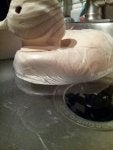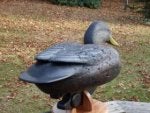I carved up my first decoy and float tested it in the sink before painting etc. It's nose heavy. How would you go about remedying that?

11,392 posts
·
Joined 2009
There are two ways to correct this:
Add some lead weight to the rear. ( I use cast .45-caliber bullets epoxied into 1/2" holes drilled in the bottom) This drops the tail.
Or,
You can epoxy some wood (floatation) to the bottom of the front of the decoy. This raises the breast.
Depends on how low the decoy rides now and how much weight you are willing to accept.
Add some lead weight to the rear. ( I use cast .45-caliber bullets epoxied into 1/2" holes drilled in the bottom) This drops the tail.
Or,
You can epoxy some wood (floatation) to the bottom of the front of the decoy. This raises the breast.
Depends on how low the decoy rides now and how much weight you are willing to accept.
2,740 posts
·
Joined 2012
Using a big rubber band with the keel and weights before permanently attaching would work.
Depends what you are going to do for a keel. If using a weighted keel obviously you could put the weights right on the keel. I've just used heavy duty waterproof adhesive.
Depends what you are going to do for a keel. If using a weighted keel obviously you could put the weights right on the keel. I've just used heavy duty waterproof adhesive.
goldfish
Discussion starter
9,857 posts
·
Joined 2011
I feel like it rides lower than I want it to in the front as is, but of course if I weighted the back it should bring the front up slightly, right? And I imagine a heavier decoy is going to ride better than a light one?
Attachments
-
57 KB Views: 1,654
2,740 posts
·
Joined 2012
Yes a heavier decoys should ride better and IMO real birds do ride lower in the water than most decoys. It's hard for me to tell from the pics if it really that bad.goldfish said:I feel like it rides lower than I want it to in the front as is, but of course if I weighted the back it should bring the front up slightly, right? And I imagine a heavier decoy is going to ride better than a light one?
If it were me I would just find some lead weights and attach them to the back.
799 posts
·
Joined 2008
Need more info.
Looks like a wooden body and head. Also looks like you don't have a keel on it yet.
I would complete the decoy and attach the keel....and then start worrying about how it floats. Everything you add to the decoy will change how it floats (wood filler, eyes, additional primer and paint, etc.), including the keel.
When I get to the final float test, I use the lead strip - type decoy weights as these are easily cut down to length.
I also use a couple of small brads or pins to attach the lead to the keel to see how it affects the decoy, and this allows you move the weight around on the keel or the decoy itself to see where the best place for it will be,...and then permanently attach the lead with a few small screws.
Looks like a wooden body and head. Also looks like you don't have a keel on it yet.
I would complete the decoy and attach the keel....and then start worrying about how it floats. Everything you add to the decoy will change how it floats (wood filler, eyes, additional primer and paint, etc.), including the keel.
When I get to the final float test, I use the lead strip - type decoy weights as these are easily cut down to length.
I also use a couple of small brads or pins to attach the lead to the keel to see how it affects the decoy, and this allows you move the weight around on the keel or the decoy itself to see where the best place for it will be,...and then permanently attach the lead with a few small screws.
goldfish
Discussion starter
9,857 posts
·
Joined 2011
Pine body, pine head. No keel. Wrapped in glad press and seal to keep it from soaking up any water as it isn't sealed yet.
If I weight it down, I suppose a white and black bufflehead isn't too bad for visibility, but I was kind of concerned about that if it went down any lower. The tail right now doesn't touch the water, and the front is almost an inch in.
If I weight it down, I suppose a white and black bufflehead isn't too bad for visibility, but I was kind of concerned about that if it went down any lower. The tail right now doesn't touch the water, and the front is almost an inch in.
799 posts
·
Joined 2008
I hear ya. It's the head that is causing the imbalance. My buffies are pine and they are hollow, and they still sit in the water quite a bit, does not affect the birds though !
You might try this solution: hollow out a large section of the body from the bottom, and take more from the head than the tail.
Attach a bottom board (1/4" veneer plywood) and check it again. Once you get it closer to level permanently attach the bottom board with caulking and brads. Then when you attach a small keel you'll be able to make fine adjustments to the way it floats by adding lead.
As you'll see in the photo I've attached, I added about 4 oz of lead to the rear - right side of the keel to get this black duck to sit perfectly level, and be self-righting.
You might try this solution: hollow out a large section of the body from the bottom, and take more from the head than the tail.
Attach a bottom board (1/4" veneer plywood) and check it again. Once you get it closer to level permanently attach the bottom board with caulking and brads. Then when you attach a small keel you'll be able to make fine adjustments to the way it floats by adding lead.
As you'll see in the photo I've attached, I added about 4 oz of lead to the rear - right side of the keel to get this black duck to sit perfectly level, and be self-righting.
Attachments
-
15.9 KB Views: 1,613
goldfish
Discussion starter
9,857 posts
·
Joined 2011
The head certainly doesn't help it. And it sits lopsided if I have the head centered, so I guess I get to have a turned head decoy (darn).
I don't have access to lead that I know of, but I do have a bunch of steel shot from work. Maybe make holes in the top of a keel, and play around with filling the holes to balance it?
Will pine soak up that much water while playing around with this? As in should I be concerned with wrapping the decoy like that or just let it dry a couple days after I get it set before sealing and painting?
I don't have access to lead that I know of, but I do have a bunch of steel shot from work. Maybe make holes in the top of a keel, and play around with filling the holes to balance it?
Will pine soak up that much water while playing around with this? As in should I be concerned with wrapping the decoy like that or just let it dry a couple days after I get it set before sealing and painting?
799 posts
·
Joined 2008
If you have a Cabela's store nearby you can get the strip lead in the decoy weight section.
I If you do any hollowing of the decoy body and use a bottom board, I would test float it using the plastic wrap again. I wouldn't put the raw pine in water.
I If you do any hollowing of the decoy body and use a bottom board, I would test float it using the plastic wrap again. I wouldn't put the raw pine in water.
2,740 posts
·
Joined 2012
I have some of no-roll lead weights that you can have if you're ever in my area (Maplewood). they're 1 and 2 oz weights.
-
?
-
?
-
?
-
?
-
?
-
?
-
?
-
?
-
?
-
?
-
?
-
?
-
?
-
?
-
?
-
?
-
?
-
?
-
?
-
?
- posts
- 3.2M
- members
- 65K
- Since
- 2000
A forum community dedicated to duck hunters and hunting enthusiasts. Come join the discussion about safety, gear, tips, tricks, optics, hunting, gunsmithing, reviews, reports, accessories, classifieds, and more!





